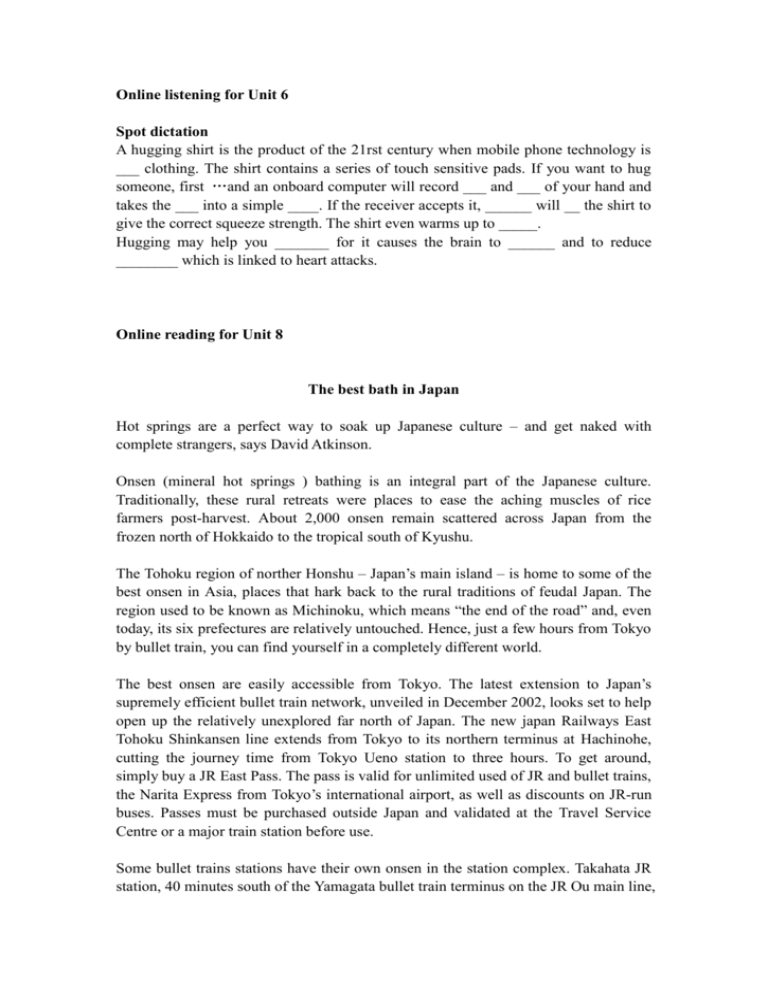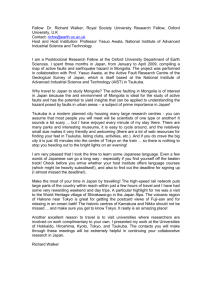The best bath in Japan
advertisement

Online listening for Unit 6 Spot dictation A hugging shirt is the product of the 21rst century when mobile phone technology is ___ clothing. The shirt contains a series of touch sensitive pads. If you want to hug someone, first …and an onboard computer will record ___ and ___ of your hand and takes the ___ into a simple ____. If the receiver accepts it, ______ will __ the shirt to give the correct squeeze strength. The shirt even warms up to _____. Hugging may help you _______ for it causes the brain to ______ and to reduce ________ which is linked to heart attacks. Online reading for Unit 8 The best bath in Japan Hot springs are a perfect way to soak up Japanese culture – and get naked with complete strangers, says David Atkinson. Onsen (mineral hot springs ) bathing is an integral part of the Japanese culture. Traditionally, these rural retreats were places to ease the aching muscles of rice farmers post-harvest. About 2,000 onsen remain scattered across Japan from the frozen north of Hokkaido to the tropical south of Kyushu. The Tohoku region of norther Honshu – Japan’s main island – is home to some of the best onsen in Asia, places that hark back to the rural traditions of feudal Japan. The region used to be known as Michinoku, which means “the end of the road” and, even today, its six prefectures are relatively untouched. Hence, just a few hours from Tokyo by bullet train, you can find yourself in a completely different world. The best onsen are easily accessible from Tokyo. The latest extension to Japan’s supremely efficient bullet train network, unveiled in December 2002, looks set to help open up the relatively unexplored far north of Japan. The new japan Railways East Tohoku Shinkansen line extends from Tokyo to its northern terminus at Hachinohe, cutting the journey time from Tokyo Ueno station to three hours. To get around, simply buy a JR East Pass. The pass is valid for unlimited used of JR and bullet trains, the Narita Express from Tokyo’s international airport, as well as discounts on JR-run buses. Passes must be purchased outside Japan and validated at the Travel Service Centre or a major train station before use. Some bullet trains stations have their own onsen in the station complex. Takahata JR station, 40 minutes south of the Yamagata bullet train terminus on the JR Ou main line, is one of the best. This provincial station has full-scale bathhouse, the Mahoroba onsen, which opens 7 a.m. – 9.30 p.m. daily. Before you strip off and dive in, a word of warning: the etiquette that accompanies getting naked with a bunch of strangers is just one of the danger areas in which unknowing visitors to Japan may find themselves – quite literally – in hot water. Get it wrong and you might as well relieve yourself in the koi carp pond – the normally polite Japanese will be seriously affronted. The key is to wash yourself outside the bath and keep the bath for soaking. Getting soap in the water is the most heinous of onsen faux pas. For onsen fans the ultimate goal is to attain a state of onsen nirvana known as yude-kako or “the boiled octopus”, which stems from several hours of serious soaking. Several onsen survive tucked away down the side streets of Tokyo’s neon-lit urban jungle. One of the best is the traditional Rokuryu in Tokyo’s Ueno district. Thissento (bathhouse) remains frozen in time and is deservedly popular with locals. The piping-hot amber waters contain mineral extracts reputedly good for skin ailments. The mountain hot-springs town of Naruko Onsen in Miyage prefecture is best know for its crowning glory. Taki-no-yu, a fabulously atmospheric wooden bathhouse. The latter has hardly changed in 150 years and continues to draw onsen aficionados from across the globe for its curative waters packed with sodium chloride and sulphur. The Zao Onsen in Yamagata prefecture, a 40-minute bus journey from Yamagata’s JR station, is a prime example of a panoramic cherry blossom vista from the outdoor hot tub. It 200-year-old dai-rotemburo (trio of outdoor pools) can hold up to 200 people and feels unashamedly traditional with the smell of sulphur coming off the water and a host of aged regulars lolling around in yukata (gowns). It opens daily 6 a.m.- sunset. Alternatively, Nyuto Onsen near Lake Tazawa in Akita prefecture is home to Ganiba Onsen Ryokan, a mixed-sex rotemburo (outdoor pool). It opens 8 a.m. – 6 p.m. daily. 1. In the sentence “Hot springs are a perfect way to soak up Japanese culture), the phrase “soak up” means… A invade B know C evaluate D control 2. From the passage we can see that Michinoku… A has kept the best onsen tradition B is completely cut off from civilization C has maintained the feudal system D has all its onsen around the end of the road 3. The most important point to remember in onsen is … A to try to avoid strangers in the hot water B to try to avoid hot water C to try not to strip off before a bunch of strangers D to rinse yourself clean before getting into the bath 4. For onsen fans, the purpose of doing onsen is … A to act like a octopus B to reach a state of utter relaxation C to soak oneself long enough so as to get rid of all the dirt D to experience the near-death feeling 5. The Onsen best known for its healing effect on the body is … A The Zao Onsen B Nyuto Onsen C Thissento D Taki-no-yu Key 1. B 2. A 3. D 4. B 5. C






